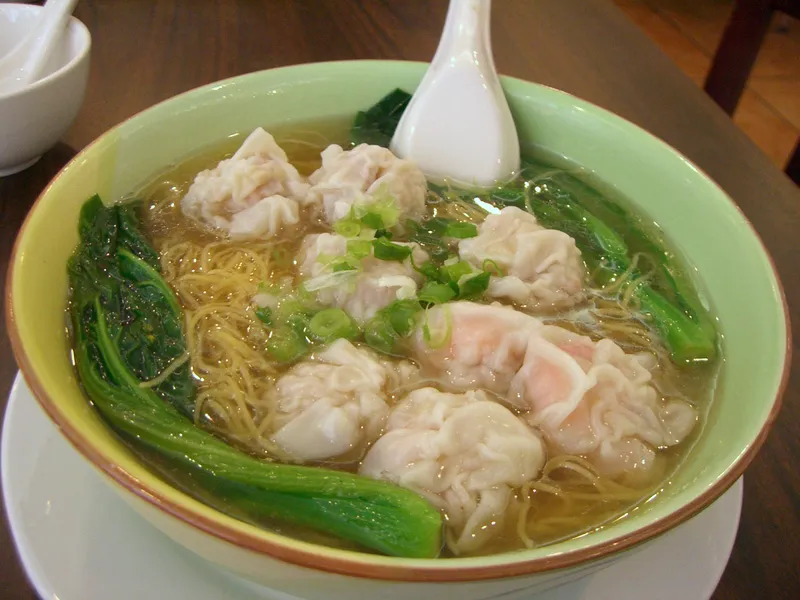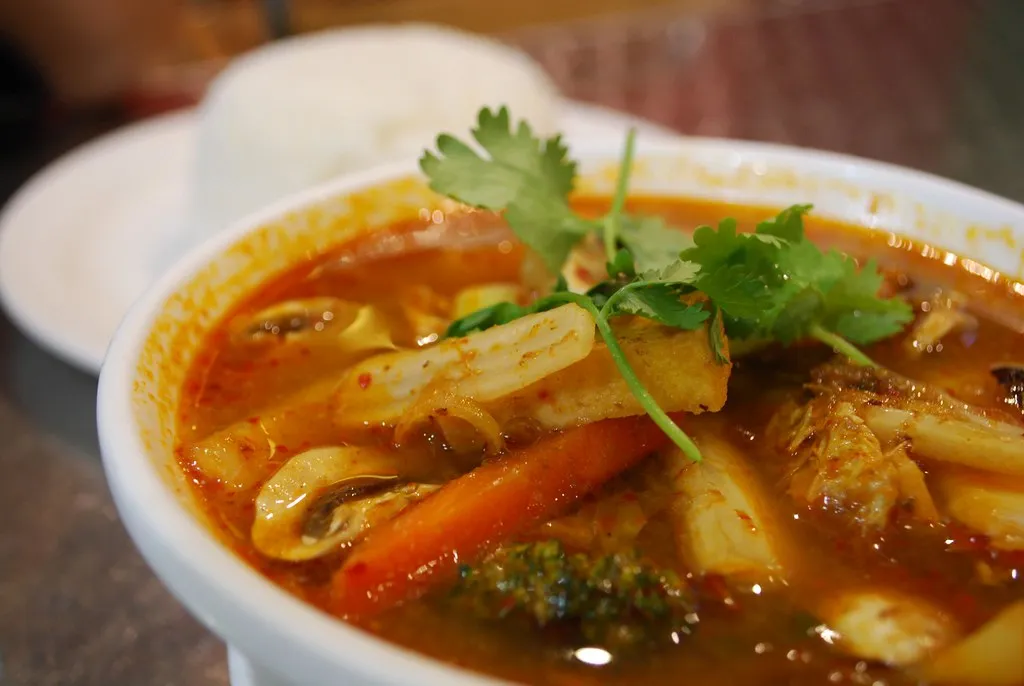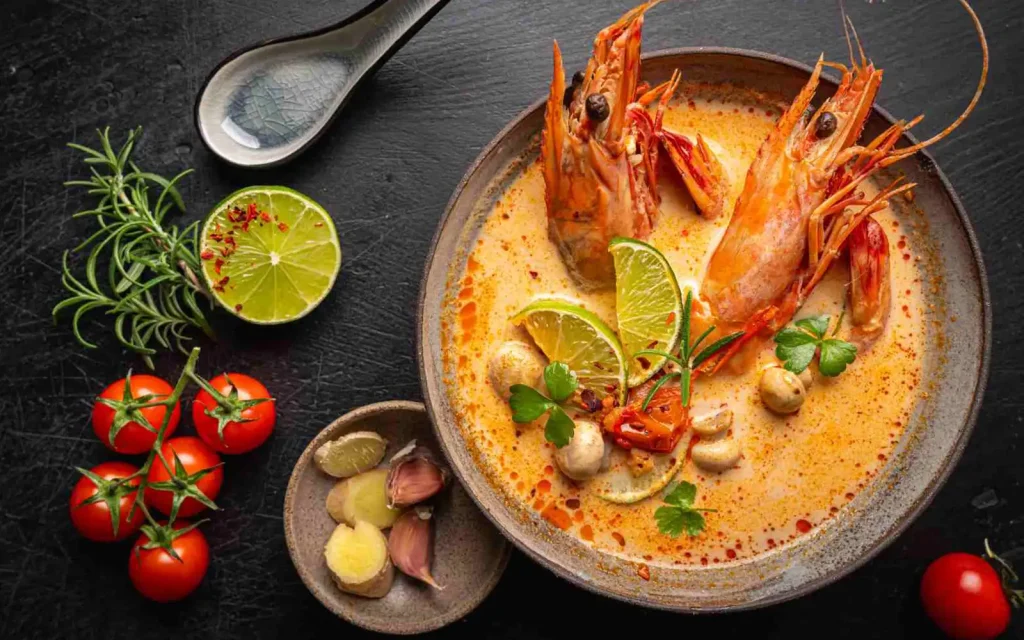The Best Fluffy Pancakes recipe you will fall in love with. Full of tips and tricks to help you make the best pancakes.
There’s nothing more comforting than a warm bowl of flavorful Oriental soup. Whether you’re craving a light and refreshing miso soup or a bold and spicy Tom Yum, these soups offer a perfect balance of taste and nutrition. Made with rich broths, fresh ingredients, and aromatic spices, Oriental soups are not only delicious but also quick and easy to prepare at home.
In this post, we’ll explore some of the best Oriental soup recipes that you can make in no time. From traditional favorites like wonton soup to spicy hot and sour soup, these bowls are packed with bold flavors and wholesome goodness. Get ready to discover how simple ingredients can create restaurant-quality soups right in your kitchen!
What Makes Oriental Soups So Special?
Oriental soups have a unique charm that sets them apart from other soups around the world. They are known for their rich flavors, nourishing ingredients, and the perfect balance of taste and texture. Whether enjoyed as a starter, a side dish, or a complete meal, these soups offer a delightful experience for the senses. Here’s what makes Oriental soups so special:

Rich and Flavorful Broths
The secret behind any great Oriental soup lies in its broth. Unlike basic stocks, these broths are infused with layers of umami flavors. Ingredients like miso paste, soy sauce, fish sauce, and dashi create deep, complex tastes that define Oriental soups. Slow-simmered broths, such as the ones used in ramen or pho, develop even richer flavors by extracting nutrients from bones, herbs, and spices. The result? A soup that’s both comforting and satisfying.
Fresh and Nutritious Ingredients
Oriental soups are packed with fresh, wholesome ingredients that make them not only delicious but also highly nutritious. Vegetables like bok choy, napa cabbage, shiitake mushrooms, and scallions add texture, vitamins, and minerals to every bowl. Proteins such as tofu, shrimp, chicken, or thinly sliced beef enhance the soup while keeping it light. Additionally, aromatics like garlic, ginger, and lemongrass provide both flavor and health benefits, making these soups a nourishing choice.
Soup is widely regarded as a healthy meal choice because of its hydrating properties, nutrient density, and ability to keep you full. To learn more about the health benefits of soups and what makes them a great addition to your diet, check out this guide from Healthline on whether soup is healthy.
Quick and Easy to Make
Despite their complex flavors, many Oriental soups are surprisingly simple to prepare. Some, like miso soup, can be made in under 10 minutes with just a few ingredients. Even more elaborate soups like wonton soup or hot and sour soup can be whipped up in less than 30 minutes. The key is using high-quality ingredients and following simple cooking techniques, making these soups perfect for busy weeknights or last-minute meals.
Whether you’re looking for a light, healthy broth or a rich, hearty meal, Oriental soups offer something for everyone. Their balance of flavor, nutrition, and convenience makes them a staple in many kitchens worldwide.
Quick and Easy Oriental Soup Recipes to Try
One of the best things about Oriental soups is how quick and easy they are to prepare while still delivering deep, comforting flavors. Whether you’re in the mood for something light and refreshing or bold and spicy, there’s a soup to satisfy every craving. Here are four must-try Oriental soup recipes that you can make at home in no time.

1. Miso Soup – A Simple and Healthy Japanese Classic
Miso soup is a staple in Japanese cuisine, known for its light yet umami-packed broth. Made with miso paste, dashi broth, and simple add-ins like tofu and seaweed, this soup comes together in just 10 minutes. The fermented miso paste not only enhances the flavor but also provides probiotics that support gut health. For extra depth, you can add mushrooms, green onions, or even a soft-boiled egg.
Ingredients:
- 2 cups dashi broth (kombu and bonito flakes simmered in water)
- 2 tbsp miso paste (white or red)
- ½ cup tofu, cubed
- 2 tbsp dried wakame (seaweed)
- 2 tbsp green onions, chopped
How to Make It:
- Prepare dashi broth by simmering kombu (seaweed) and bonito flakes. Strain out solids.
- In a small bowl, dissolve miso paste in a ladle of warm broth, then stir it into the pot.
- Add tofu cubes, seaweed, and green onions.
- Serve hot and enjoy!
2. Hot and Sour Soup – A Spicy and Tangy Chinese Favorite
Hot and sour soup is a go-to comfort dish in Chinese cuisine, offering the perfect balance of heat and tanginess. With ingredients like vinegar, white pepper, soy sauce, and mushrooms, this soup has a bold and irresistible flavor. It often includes tofu and egg ribbons for added texture. The best part? You can make it in less than 20 minutes!
Ingredients:
- 4 cups chicken or vegetable broth
- 1 cup mushrooms, sliced
- 1 cup tofu, cubed
- 2 tbsp soy sauce
- 2 tbsp rice vinegar
- ½ tsp white pepper
- 1 egg, beaten
- 1 tbsp cornstarch mixed with 2 tbsp water (slurry)
- 2 tbsp green onions, chopped
How to Make It:
- Sauté garlic and ginger in a pot. Add mushrooms and broth, bringing it to a simmer.
- Stir in soy sauce, vinegar, and white pepper for the signature hot and sour taste.
- Add tofu and slowly drizzle in beaten eggs while stirring to create silky ribbons.
- Stir in cornstarch slurry to thicken the soup slightly.
- Garnish with green onions and serve warm.
3. Tom Yum Soup – A Bold and Aromatic Thai Delight
Tom Yum soup is a classic Thai dish that bursts with spicy, sour, and citrusy flavors. Its fragrant broth is infused with lemongrass, lime leaves, and chili, making it both refreshing and deeply satisfying. This soup is often made with shrimp or chicken, but you can easily make a vegetarian version by using mushrooms.
Ingredients:
- 4 cups chicken or vegetable broth
- 2 stalks lemongrass, smashed
- 3 kaffir lime leaves, torn
- 1-inch galangal (or ginger), sliced
- 1 tbsp fish sauce (or soy sauce for vegetarian)
- 1 tbsp lime juice
- 1 tbsp Thai chili paste (Nam Prik Pao)
- ½ cup mushrooms, sliced
- ½ cup shrimp or chicken
- 1 tomato, chopped
- Fresh cilantro and lime wedges for garnish
How to Make It:
- Boil the broth and add smashed lemongrass, lime leaves, and galangal. Let it simmer for 5 minutes.
- Stir in fish sauce, lime juice, and chili paste for a perfect balance of flavors.
- Add shrimp, mushrooms, and tomatoes, cooking until tender (about 5 minutes).
- Garnish with fresh cilantro and serve with a wedge of lime.
4. Wonton Soup – A Comforting Chinese Classic
Wonton soup is a light yet satisfying dish featuring delicate dumplings floating in a flavorful broth. The dumplings are typically filled with ground pork and shrimp, but you can also use chicken or a vegetarian filling. Though it may seem fancy, wonton soup is actually very simple to prepare at home.
Ingredients:
For the Wontons:
- 20 wonton wrappers
- ½ cup ground pork
- ½ cup shrimp, finely chopped
- 1 tsp soy sauce
- 1 tsp ginger, grated
- 1 tsp sesame oil
For the Broth:
- 4 cups chicken broth
- 2 garlic cloves, minced
- 1-inch ginger, sliced
- 1 tbsp soy sauce
- 2 tbsp green onions, chopped
How to Make It:
- Mix ground pork, shrimp, soy sauce, ginger, and sesame oil in a bowl.
- Place a small spoonful of the filling onto each wonton wrapper, fold, and seal the edges with water.
- Bring a pot of water to a boil and cook the wontons until they float (about 3-4 minutes). Remove and set aside.
- In another pot, simmer chicken broth with garlic, ginger, and soy sauce for 5 minutes.
- Add the wontons to the broth, garnish with green onions, and serve hot.
Bonus: Try a Unique Soup Recipe from El Salvador!
If you love trying different soups from around the world, why not explore a unique Latin American soup? El Salvadoran Corn Soup is a delicious and traditional dish packed with rich flavors. Check out this Authentic El Salvadoran Corn Soup Recipe for a taste of El Salvador in a bowl!
Pro Tips for Making the Best Oriental Soups
Making authentic and flavorful Oriental soups at home is easier than you think. With the right ingredients, techniques, and a few expert tips, you can create restaurant-quality soups that are rich, aromatic, and deeply satisfying. Here are some pro tips to elevate your Oriental soup-making game.

1. Use Homemade Broth for Deeper Flavor
The key to a great Oriental soup starts with a flavorful broth. While store-bought broths can work in a pinch, making your own can significantly enhance the depth and authenticity of the dish.
How to Make a Rich and Authentic Broth:
- For Japanese soups (e.g., miso soup, ramen): Use dashi broth made from kombu (seaweed) and bonito flakes for a naturally umami-rich base.
- For Chinese soups (e.g., wonton soup, hot and sour soup): Simmer chicken bones, ginger, and scallions for a clear yet flavorful broth.
- For Thai soups (e.g., Tom Yum, Tom Kha): Infuse broth with lemongrass, kaffir lime leaves, and galangal to create a fragrant and tangy base.
If you’re short on time, you can enhance store-bought broth by simmering it with aromatics like ginger, garlic, or dried mushrooms for a more complex taste.
2. Balance the Flavors Like a Pro
Oriental soups are all about balance—combining salty, sweet, sour, spicy, and umami elements to create a harmonious dish. Mastering this balance ensures your soup is flavorful and well-rounded.
How to Achieve the Perfect Flavor Balance:
- Umami (Depth & Savory Taste): Use miso paste, soy sauce, fish sauce, or dashi.
- Saltiness: Adjust with soy sauce, salt, or tamari.
- Sweetness: A touch of sugar, mirin, or coconut milk can mellow sharp flavors.
- Sourness: Add rice vinegar, lime juice, or tamarind paste to brighten the soup.
- Spiciness: Incorporate chili paste, white pepper, or fresh chili slices for heat.
Pro Tip: Taste as you cook! Adjust the seasonings gradually to find the perfect balance that suits your taste buds.
3. Enhance Your Soup with Fresh Herbs and Aromatics
One of the easiest ways to elevate an Oriental soup is by incorporating fresh herbs and aromatics. These ingredients add fragrance, depth, and complexity to your dish.
Must-Have Herbs and Aromatics for Oriental Soups:
- Garlic and Ginger: These two are essential in many Oriental broths for an earthy and slightly spicy kick.
- Scallions (Green Onions): Adds a mild onion flavor and a fresh, bright finish to any soup.
- Cilantro (Coriander Leaves): Perfect for Thai and Chinese soups, giving a citrusy and slightly peppery taste.
- Lemongrass: Common in Thai soups like Tom Yum, adding a fresh and citrusy aroma.
- Star Anise and Cinnamon: Used in slow-simmered broths (like pho) to create a deep and slightly sweet warmth.
Pro Tip: Always add delicate herbs (like cilantro or green onions) at the end of cooking to preserve their fresh flavor and aroma.
4. Choose the Right Protein and Cook It Correctly
Adding protein to your soup can turn it into a hearty meal, but it’s important to cook it properly to maintain tenderness and flavor.
Best Proteins for Oriental Soups and Cooking Tips:
- Chicken: Slice it thinly and add it towards the end to keep it juicy. For shredded chicken, simmer bone-in pieces and pull them apart after cooking.
- Tofu: Use firm tofu for cubed additions or silken tofu for a smooth texture in soups like miso soup and hot and sour soup.
- Shrimp & Seafood: Add seafood last, as overcooking can make it tough. In Tom Yum soup, shrimp should be pink and just cooked through.
- Beef: For soups like pho, use thinly sliced raw beef and pour hot broth over it to gently cook it without making it chewy.
Pro Tip: Marinate proteins (especially chicken and beef) in soy sauce, sesame oil, and a pinch of sugar before adding them to the soup for extra flavor.
5. Don’t Forget the Toppings and Garnishes
The right toppings and garnishes can take your soup from good to amazing. They add texture, extra flavor, and visual appeal.
Topping Ideas for Oriental Soups:
- Crispy Additions: Fried shallots, wonton strips, tempura bits for a crunchy contrast.
- Noodles and Rice: Ramen, udon, glass noodles, or jasmine rice make soups heartier.
- Eggs: A soft-boiled egg in ramen or beaten eggs in hot and sour soup adds richness.
- Condiments: Chili oil, sesame seeds, or a drizzle of soy sauce for extra depth.
- Fresh Herbs: Cilantro, basil, or scallions for a refreshing finish.
Pro Tip: Add toppings just before serving to keep them fresh and flavorful.
Best Toppings and Side Dishes for Oriental Soups
A bowl of Oriental soup is already packed with flavor, but the right toppings and side dishes can take it to a whole new level. Whether you’re looking for extra crunch, a boost of umami, or a hearty addition, these garnishes and accompaniments will enhance both the texture and taste of your favorite soups. From crispy toppings to flavorful sides, here’s how to elevate your Oriental soup experience.

1. Noodles and Rice – Hearty Additions to Make It a Meal
While some Oriental soups, like miso soup, are traditionally served as a light starter, others can be transformed into a filling meal with the addition of noodles or rice.
Best Noodles for Oriental Soups:
- Ramen Noodles – Perfect for Japanese ramen-based soups, these wavy noodles absorb broth well.
- Udon Noodles – Thick, chewy noodles that work well in hearty broths.
- Rice Noodles (Vermicelli or Pho Noodles) – Light and delicate, these are ideal for soups like pho or Tom Yum.
- Glass Noodles (Cellophane Noodles) – A transparent noodle made from starch, great for adding a unique texture.
- Egg Noodles – Commonly used in Chinese soups like wonton noodle soup for a slightly chewy and eggy flavor.
Rice Options for Soup Pairings:
- Steamed Jasmine Rice – The perfect side for strong-flavored soups like hot and sour soup or Tom Yum.
- Sticky Rice – Pairs well with Thai soups, especially those with coconut-based broths.
- Fried Rice – A flavorful side dish that can turn your soup into a full meal.
Pro Tip: If adding noodles directly to the soup, cook them separately first to avoid excess starch thickening the broth.
2. Crispy Additions – Adding a Crunchy Contrast
A bit of crunch can add an exciting contrast to a warm and silky soup. These crispy toppings not only enhance texture but also bring extra layers of flavor.
Crispy Toppings to Try:
- Fried Shallots – A classic topping that adds a sweet, crispy texture to soups like pho and wonton soup.
- Wonton Strips – Fried wonton pieces bring a satisfying crunch to any broth.
- Tempura Bits (Tenkasu) – Commonly used in Japanese udon soups to add a light, crispy texture.
- Toasted Sesame Seeds – Adds a subtle nutty flavor and a delicate crunch.
- Crushed Peanuts – Often sprinkled over Thai soups like Tom Yum for an added crunch.
Pro Tip: Always add crispy toppings right before serving to maintain their crunchiness.
3. Fresh Herbs and Aromatics – Elevating the Flavor
Fresh herbs and aromatics bring brightness, fragrance, and a burst of fresh flavor to Oriental soups. These ingredients complement the depth of the broth while adding their own unique character.
Must-Try Herbs and Aromatics:
- Cilantro (Coriander Leaves) – A staple in Thai and Vietnamese soups, adding a citrusy, peppery taste.
- Scallions (Green Onions) – Provides a mild onion-like sharpness that works well in almost any soup.
- Thai Basil – A great addition to pho or Tom Yum, adding a slightly sweet and spicy aroma.
- Lime Wedges – Commonly served with Thai and Vietnamese soups, adding a tangy freshness.
- Chili Slices (Fresh or Dried) – Enhances heat levels for those who enjoy spicy soups.
- Pickled Vegetables – A great way to add a touch of acidity and crunch.
Pro Tip: Add fresh herbs at the very end of cooking or right before serving to preserve their delicate flavors.
4. Flavor-Boosting Condiments – Customizing Your Bowl
One of the best things about Oriental soups is that they can be customized with condiments to match your personal taste. A small drizzle or sprinkle of the right ingredient can transform your soup experience.
Popular Soup Condiments:
- Soy Sauce or Tamari – Enhances the savory and umami flavors.
- Chili Oil or Sriracha – Perfect for adding heat to mild soups.
- Hoisin Sauce – Adds a touch of sweetness and depth, often used in pho.
- Fish Sauce – Essential for Southeast Asian soups, adding a salty, umami depth.
- Sesame Oil – A small drizzle brings out a nutty aroma.
- Black Vinegar – Often used in Chinese soups like hot and sour soup for a tangy, deep flavor.
Pro Tip: Serve condiments on the side so everyone can adjust the flavors to their liking.
5. Side Dishes – Perfect Complements to Your Soup
A great side dish can turn a simple bowl of soup into a complete and satisfying meal. Here are some of the best side dishes to serve with Oriental soups.
Classic Side Dishes to Try:
- Spring Rolls (Fresh or Fried) – Vietnamese fresh spring rolls (gỏi cuốn) pair beautifully with pho, while crispy egg rolls complement Chinese soups.
- Steamed Dumplings – A great pairing with light broths like miso soup or wonton soup.
- Bao Buns – Soft, pillowy buns filled with pork or vegetables make a great side for hearty soups.
- Gyoza (Japanese Dumplings) – Pan-fried dumplings that add an extra savory element.
- Scallion Pancakes – A crispy and flavorful Chinese-style pancake that complements any soup.
- Pickled Vegetables – A refreshing side that balances the richness of broth-based soups.
Pro Tip: Choose a side dish with a contrasting texture to make the meal more enjoyable—for example, a crispy dish like gyoza with a light soup like miso.
Oriental soups are more than just a warm and comforting meal—they are a celebration of rich flavors, balanced ingredients, and time-honored traditions. Whether you prefer a light and refreshing miso soup, a spicy and aromatic Tom Yum, or a hearty bowl of ramen, there’s an Oriental soup for every taste and occasion.
By using a flavorful broth, balancing the key elements of taste, and incorporating fresh herbs, crispy toppings, and delicious side dishes, you can elevate your homemade soups to restaurant-quality levels. Don’t be afraid to experiment with different ingredients, noodles, and condiments to find your perfect bowl.
Now that you have the best recipes, pro tips, and pairing ideas, it’s time to start cooking! Which Oriental soup will you try first? Let us know your favorite combinations and toppings in the comments below. Happy cooking!






[…] This article explores a variety of Oriental soup recipes, offering rich broths, flavorful toppings, and easy cooking tips for comforting homemade meals. It’s an excellent resource for readers interested in expanding their soup repertoire with Asian-inspired flavors.fastprepkitchen […]
These are actually great ideas in about blogging. You have touched some pleasant things here. Any way keep up wrinting.
Thanks , I’ve just been looking for information approximately this topic for a while and yours is the greatest I’ve found out so far. But, what about the conclusion? Are you certain about the supply?
Thank you for any other fantastic article. The place else may anyone get that type of info in such an ideal means of writing? I have a presentation subsequent week, and I’m at the search for such information.
Now I am ready to do my breakfast, once having my breakfast coming over again to read more news http://www.kayswell.com
I’d like to thank you for the efforts you have put in writing this blog.I’m hoping to check out the same high-grade content from you later on as well. In truth, your creative writing abilities has motivated me to get my very own website now 😉
Great blog you’ve got here.. It’s difficult to find excellent writing like yours these days. I seriously appreciate individuals like you! Take care!! http://www.ifashionstyles.com
Somebody essentially assist to make critically posts I would state. That is the first time I frequented your website page and to this point? I amazed with the research you made to make this actual put up amazing. Magnificent task!
It’s in point of fact a great and useful piece of info.I am glad that you just shared this useful info with us.Please keep us informed like this. Thanks for sharing.
Hello, I enjoy reading through your article. I wanted to write a little comment to support you.
We stumbled over here coming from a different web page and thought I might check things out. I like what I see so now i’m following you.Look forward to finding out about your web page yet again.
That is the precise blog for anybody who desires to seek out out about this topic. You realize so much its almost exhausting to argue with you (not that I truly would need匟aHa). You undoubtedly put a brand new spin on a subject thats been written about for years. Great stuff, simply nice!
You really make it seem so easy with your presentation but I find this topic to be really something that I think I would never understand. It seems too complex and very broad for me. I’m looking forward for your next post, I will try to get the hang of it!